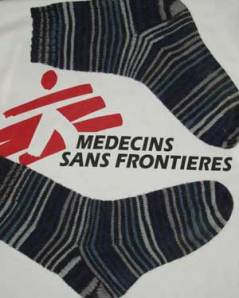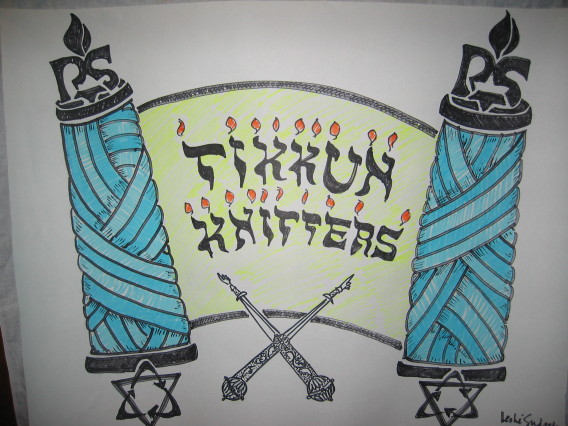Well, it’s mostly quiet in the Gaza region, for the time being. Rocket fire into Israel from Gaza has slowed, and humanitarian aid for civilians is getting into Gaza,  albeit at a rate less then optimal.
albeit at a rate less then optimal.
Rather than hold my breath – and hands – waiting for the parties to make their peace, I’m still looking for a wider community committed to that peace. I’m heartened by recent requests for a pattern for my knitted olive branch. The process is a simple one: knit some olives, start knitting a branch and leaves, and knit the olives onto the branch as you go.
TikkunTree Olive Branch
Materials:
– worsted weight yarn (I used Araucania Nature Wool Solids, two shades of mottled green), a few yards for each olive, more for the branch and leaves
– one set of US 3 (3.25 mm) double point needles
– one set of US 4 (3.5 mm) double point needles
stitch holder/s
– a small amount of stuffing material (a finely shredded, clean plastic bag will do just as well as polyfill stuffing)
Instructions:
Knit 5-8 olives with stems (large and small, green and/or black) and set aside on stitch holder/s or another needle.
To make an olive:
CO 6 (long-tail), divide onto 3 dpns, join without twisting and mark beginning of the round
Row 1 (and all odd rows): knit
Row 2: *k1, M1 (ladder-lift increase), k1*, repeat ** to end of round (9 sts)
Row 4: *k1, M1, k2*, k1*, repeat ** to end of round (12 sts)
Row 6: *k1, M1, k3*, k1*, repeat ** to end of round (15 sts)
Row 8: *k1, M1, k3*, k1*, repeat ** to end of round (18 sts)
Row 10: *k1, M1, k3*, k1*, repeat ** to end of round (21 sts)
Rows 11-13: knit
Row 14: *k2tog, k4*, k1*, repeat ** to end of round (18 sts)
Row 16: *k2tog, k3*, k1*, repeat ** to end of round (15 sts)
Row 18: *k2tog, k2*, k1*, repeat ** to end of round (12 sts)
Stuff the olive lightly and continue to close the top of the olive:
Row 20: *k2tog* to end of round (6 sts)
Row 21: *k2 tog* to end of round (3)
Row 22: k2tog, k1
Continue to make stem for olive on branch: work remaining 2 sts in I-cord (knit the sts, don’t turn; slip the sts back to the beginning of the needle and knit again) for 3-5 rows
Cut a 3” tail for weaving later, and slip these 2 sts to a holder or another needle and Cut a 3” tail for weaving later.
Start the olive branch and leaves:
CO 5 sts in green or brown
Work in I-cord for 2-4”.
Begin working leaves on the stem and knit in the olives as you go.
To make olive branch leaves:
Start with one st from the I cord branch (from either end of the dpn), then CO 15-20 sts (backward loops works fine; other techniques are described here here).
BO 5 sts loosely.
K remaining new sts, slip last st knitted back to other (LH) needle, turn.
K to next to last st, turn (1 st is on the RH needle), slip 1 st from LN to RN, and BO 1st st, then
• continue to knit and BO the remaining sts (for slim leaf)
• or repeat above if making a larger leaf (20+ sts) – BO 5, K, k back, then BO remaining sts.
To knit-in an olive on the left side of the branch
• prepare by loading an olive to the left of the branch (place sts on the left side of the LH dpn)
• knit the first 2 sts of the I-cord branch, k2tog, k2tog (last st of the branch and the 1st st of the olive stem), k1 (2nd st of the olive stem) (5 sts)
To knit-in an olive on the right side of the branch
• prepare by loading an olive to the right of the branch (place sts on the right side of the LH dpn)
• k1 (1st st of the olive stem), K2 tog (2nd st of the olive stem and 1st st of the branch), k3
Continue to knit the branch and leaves, adding olives as you go, until you have used up your olives and/or the branch is the desired length.
This pattern is copyright protected. Feel free to use this pattern for non-commercial purposes only. Feel free to contact me if you have questions or concerns about the pattern. I’m indebted to Mary Jane, Midge and Mink for the inspiration of their Olive Tutorial.
© 2009 TikkunArts. All Rights Reserved.
 albeit at a rate less then optimal.
albeit at a rate less then optimal.







 The broohaha over Sarah Palin’s nomination prompted a brief flight into fanciful crochet, and I spent a few weeks feverishly
The broohaha over Sarah Palin’s nomination prompted a brief flight into fanciful crochet, and I spent a few weeks feverishly  I embroidered as donations to the pool of items auctioned by
I embroidered as donations to the pool of items auctioned by 

 The Beijing Summer Olympics in August inspired nearly four thousand craftspeople to make and finish tens of thousands of projects. As a participant in the “Hat Dash”, I produced five small hats for the
The Beijing Summer Olympics in August inspired nearly four thousand craftspeople to make and finish tens of thousands of projects. As a participant in the “Hat Dash”, I produced five small hats for the 
 I finished a knitted shofar and pomegranate, symbols of the holiday. For Sukkot, I added some new knitted and felted etrogs to our family sukkah, to make the space even more hospitable to visiting interfaith and peace groups. (
I finished a knitted shofar and pomegranate, symbols of the holiday. For Sukkot, I added some new knitted and felted etrogs to our family sukkah, to make the space even more hospitable to visiting interfaith and peace groups. ( I signed on to the project early, claiming the flags of Israel and
I signed on to the project early, claiming the flags of Israel and  Palestine for (for obvious reasons), as well as the flag of Cambodia (in honor of my friend Onn, a survivor of the genocide). I tackled Cambodian flag first in August, exploring ways to translate into knitting the special structural details of the 11th-c.
Palestine for (for obvious reasons), as well as the flag of Cambodia (in honor of my friend Onn, a survivor of the genocide). I tackled Cambodian flag first in August, exploring ways to translate into knitting the special structural details of the 11th-c.  to reflect my understanding of the ways in
to reflect my understanding of the ways in  which these two peoples inextricably bound to the same texts and terrain. I eventually settled on joining the flags by way of the intertwined (cabled) trunk of a olive tree (of life), rather than the conjoined bodies of twins, which is how I’ve formulated the relationship previously (as
which these two peoples inextricably bound to the same texts and terrain. I eventually settled on joining the flags by way of the intertwined (cabled) trunk of a olive tree (of life), rather than the conjoined bodies of twins, which is how I’ve formulated the relationship previously (as  But earlier this week I was amazed to learn that the TikkunTree project has been included among the on the
But earlier this week I was amazed to learn that the TikkunTree project has been included among the on the 


 What conversations about or efforts for mid-east peace might this new growth on the TikkunTree stimulate? For me, renewed effort to find more information about the peacebuilding work in Israel-Palestine. Last week I made time to read all the reports on recent Israeli-Palestinian dialogue projects contained in a recent issue of
What conversations about or efforts for mid-east peace might this new growth on the TikkunTree stimulate? For me, renewed effort to find more information about the peacebuilding work in Israel-Palestine. Last week I made time to read all the reports on recent Israeli-Palestinian dialogue projects contained in a recent issue of 



